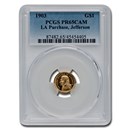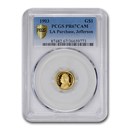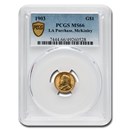Classic U.S. Gold Commemorative Coins
Minted to commemorate important events and noteworthy people in American history, commemorative coins were issued between 1892, for the World's Columbian Exposition, and 1954, for Booker T. Washington and George Washington Carver. Each of these coins carries a multifaceted historical component. These coins not only depict a piece of American history, but they are a piece of history themselves. Some of the nation’s greatest sculptors – Charles Barber, George Morgan, James Earle Fraser – all designed classic U.S. commemorative coins. Many collectors consider these gold coins as some of the most beautiful designs our nation has ever issued.
During this time period, the U.S. Mint issued a series of gold commemorative coins to mark important events or honor notable individuals. These coins were produced in various denominations, including $1, $2.50, $5, $10, and $50.
Some of the most notable classic U.S. gold commemorative coins include:
- The Columbian Exposition Half Dollar: This coin was issued in 1892 to commemorate the 400th anniversary of Christopher Columbus's arrival in the Americas. It features Columbus's portrait on the obverse and an allegorical figure of America on the reverse.
- The Louisiana Purchase Exposition Gold Dollar: This coin was issued in 1903 to mark the Louisiana Purchase Exposition, a world's fair held in St. Louis, Missouri. It features Thomas Jefferson's portrait on the obverse and an eagle on the reverse.
- The Panama-Pacific Exposition $50 Gold Piece: This coin was issued in 1915 to commemorate the Panama-Pacific International Exposition, held in San Francisco to celebrate the completion of the Panama Canal. It features a representation of Columbia on the obverse and an eagle on the reverse.
- The Sesquicentennial of American Independence Half Dollar: This coin was issued in 1926 to mark the 150th anniversary of American independence. It features George Washington's portrait on the obverse and Independence Hall on the reverse.
- The Texas Centennial Half Dollar: This coin was issued in 1934 to commemorate the centennial of Texas's independence from Mexico. It features an allegorical figure of Texas on the obverse and the Alamo on the reverse.
These coins are highly collectible today and are sought after by numismatists and coin collectors.
History of the United States Mint
The U.S. Mint was established by the Coinage Act of 1792, which was signed into law by President George Washington. The act created the Mint as a federal institution responsible for producing and regulating the nation's coinage.
The first Mint building was located in Philadelphia, Pennsylvania, and it began operations in 1793. The Mint's primary mission was to produce coins for circulation, and it did so using manual labor and primitive machinery.
In the early years, the Mint faced many challenges, including a shortage of silver and copper, and difficulties with producing coins that were consistent in quality and weight. Over time, the Mint improved its processes and technologies, including the adoption of steam power and the introduction of coin presses capable of producing higher volumes of coins.
In the late 19th and early 20th centuries, the Mint expanded its operations to include the production of commemorative coins, medals, and other items. The Mint also opened new facilities in other cities, including Denver, San Francisco, and West Point, to meet the growing demand for coinage.
Today, the U.S. Mint is responsible for producing all U.S. coins, including circulating coins, commemorative coins, and bullion coins. It also produces medals and other numismatic items and operates several facilities across the country.
Overall, the U.S. Mint has played an important role in American history, helping to establish the nation's currency, and symbolizing the country's economic and cultural growth over the centuries.
































